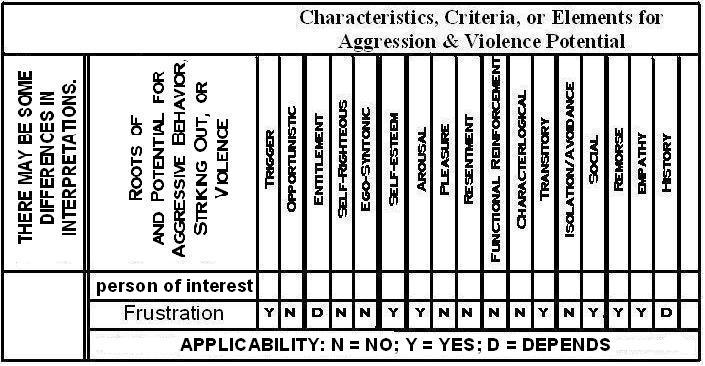9. Carter and Audrey- Frustration - RonaldMah
Ronald Mah, M.A., Ph.D.

Licensed Marriage & Family Therapist,
Consultant/Trainer/Author
Main menu:
9. Carter and Audrey- Frustration
Therapist Resources > Therapy Books > How Dangerous

How Dangerous is this Person? Assessing Danger & Violence Potential Before Tragedy Strikes
Chapter 9: CARTER AND AUDREY- FRUSTRATION
by Ronald Mah

Chapter 9: CARTER AND AUDREY- FRUSTRATION

FRUSTRATION: Characteristics, Criteria, or Elements for Aggression & Violence Potential
-- Code: NO=not applicable; YES=applicable; DEPENDS= Depends on other issues or occurs sometimes
FRUSTRATION: YES, Specific Triggering EventFRUSTRATION: NO, Opportunistic BehaviorFRUSTRATION: DEPENDS, Sense of EntitlementFRUSTRATION: NO, Self-Righteous AttitudeFRUSTRATION: NO, Ego-syntonic PerceptionFRUSTRATION: YES, Self-Esteem Gain or LossFRUSTRATION: YES, Intense Emotional ArousalFRUSTRATION: NO, PleasureFRUSTRATION: NO, ResentmentFRUSTRATION: NO, Functional Reinforcement (positive or negative)FRUSTRATION: NO, Characterlogical Behavior/PerceptionsFRUSTRATION: YES, Transitory Behavior/PerceptionsFRUSTRATION: NO, Isolation/Avoidance BehaviorFRUSTRATION: YES, SocialFRUSTRATION: YES, Presence of RemorseFRUSTRATION: YES, EmpathyFRUSTRATION: DEPENDS, History
Carter and Audrey began couples therapy at Carter’s insistence. After a long difficult week at work with the administration having warned staff of impending layoffs, Carter had stopped for a couple of beers on the way home. He got home late to sick kids, a messy house, and a frazzled Audrey. There was a charge card bill that took them way beyond their budget limitations. His sports memorabilia was on it and so was Audrey’s new dress. They got into an argument. They had arguments before and could get pretty intense, but they never got out of hand. This time Audrey got into his face and yelled at him. Carter pushed her away roughly and she stumbled and bumped her elbow. They were both stunned and the kids were crying. Carter said he had to come to therapy to make sure he never hurt Audrey again. His father had been abusive and had always taught him that he needed to “man up” and not let anyone, especially a woman push him around. Carter had rejected this, but he knew he had residual macho inclinations.
The work stress and situation, the charge card bill, and household chaos along with Audrey in his face were all triggers, and clearly Carter had not been waiting for an opportunity to strike out at Audrey. He felt that he was entitled to be assertive and sometimes aggressive. Doing so in self-defense was acceptable. However he knew that Audrey was not attacking him… but in the moment he lost it. Rather than being self-righteous about his behavior, he was ashamed. He was extremely remorseful. It was not ego-syntonic. By pushing Audrey he had betrayed the man and husband he aspired to be. No doubt he was aroused in the midst of the argument. He was pissed for sure, but he did not get any pleasure out of pushing Audrey. He also did not have a load of grievances or resentments about her or their relationship. His bad mood was all about work along with the disinhibiting effect of alcohol. Carter got nothing positive out of his aggression. His kids and Audrey were scared of him. Although their fear was only temporary, their distancing themselves from him punished Carter. Worse yet, he was devastated to see the fear in their eyes. Carter related it to how he felt as a child when his father went into a rage. His empathy for their fear humiliated him. He also hated being isolated and feeling rejected by the family. This was a one and only incident. It had never occurred before. He could get really upset and spout off, but he had no prior history of aggression or violence in other parts of his life. It was not him- not characterological. Some individuals have a greater history of lashing out when frustrated. Carter’s anger and frustration came and went. And this time, his aggression leaked out inappropriately. In all probability it would not return primarily because of his commitment and secondarily as he develops skills and mechanisms for dealing with stress and self-care.
Carter’s violence potential is very low. The therapist or professional’s best guess is that it is unlikely given his profile that he would repeat his aggression or violence. The layperson would probably agree. Both Carter and Audrey would concur as well as most people who know Carter, his personality, and his history. The therapist or professional's assessment of Carter’s characteristics, which is under a general category of frustration-based aggression, is not exactly the same as Jim’s profile. Jim’s profile also fits under frustration-based aggression. While their specific assessments are not identical, their overall quality of presentation is similar and Carter's behavior can be considered primarily from frustration. There are substantial differences in the circumstances that Carter and Jim were operating in, along with important differences in experiential history and personality. Carter and Jim, moreover share several “entries” to intervention and change. These are areas and issues, that the therapist or professional can prompt or activate Carter or Jim's motivation for altering behavior. These include remorse, desire to be social, a non-violent ideal self or identity, experience of violence being non-reinforcing (punishing), and identifiable triggers to avoid or problem-solve. These principles for interaction may be relevant if the layperson needs to deal with frustration-based aggression or behavior by various family members, colleagues, and neighbors
If frustration is the key energy for behavior, the probability of aggression is relatively low in the normal course of the person's life and relationships. However, in situations where the individual is triggered by frustration, habitual responses will come out. The therapist, professional, or other concerned person should identify habitual frustration-based behaviors that may be problematic. One individual may be comparably frustrated relative to another individual, but his or her instinctive response may be shutting down, becoming sullen, engaging in physical activity, prayer, drinking alcohol, or another behavior that is not aggressively targeted in a manner to harm another person. The functionality of the frustration response personally, interpersonally, socially, or at work may be the subject of attention with the therapist, professional, or other concerned person. However, unless there is an aggressive element affecting others directly, there is low danger or violence potential. If frustration for the individual tends to be expressed aggressively in some verbal, emotional, or psychological assault on others, the therapist, professional, or other concerned person may intervene or help the individual to better manage his or her emotional reactivity without harming his or her relationships. Assessment looks to see if there may be significant emotional or psychological damages with physical danger or violence potential remaining unlikely. This is a critical assessment since while emotional or psychological abuse is not always accompanied by physical violence, physical abuse or violence is often hand in hand with emotional and psychological abuse against another person- especially, if there is an existing conflictual relationship.
The intensity of the person's frustration and emotional reactivity, his or her ability to manage or limit reflexive aggressive responses, emotional, psychological, and developmental maturity, and cognitive self-awareness are among the areas to assess. In addition, environmental and social circumstances should also be examined for potential for being targeted and vulnerability of others to physical harm. For example, someone who stomps his or her feet or lets out an angry frustrated shout is unlikely to hurt anyone, especially if done after leaving the room or in the backyard. The violence or danger potential increases for someone who habitually lashes out physically or expresses the rage driving a car on the freeway. If an aggressive or violent behavior occurs in relatively commonplace circumstances with normal demands and stresses, including among familiar people, there should be greater concern for repetition and higher future violence potential. In other words, an extreme reaction especially an aggressive or violent reaction to common life challenges indicates volatility that requires further scrutiny. On the other hand, as in the case with Carter with an unfamiliar and unusual set of family circumstances involving unprecedented stress leading to the aggression, the potential for further violence is much lower. The therapist, professional, or other concerned person should also look to whether the individual often or consistently has to function in highly stressful and frustrating situations. Or, has grown up in or existed in such situations and may therefore, have learned dysfunctional responses and anticipates additional denigrating frustration in a new situation. Such developmental and/or consistent experiences wear down a person's capacity to tolerate frustration and not act out. This would be relevant, for example with an individual who was raised in an oppressive abusive family or chaotic and violent community may have a low frustration threshold and habitual aggressive or violent responses.

